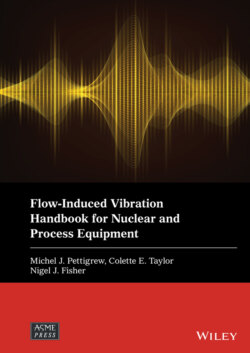Читать книгу Flow-Induced Vibration Handbook for Nuclear and Process Equipment - Группа авторов - Страница 30
2.3.1 Hydrodynamic Mass
ОглавлениеHydrodynamic mass is the equivalent dynamic mass of external fluid vibrating with the tube. In liquid flow, the hydrodynamic mass per unit length of a tube confined within a tube bundle may be expressed by
Fig. 2-6 Hydrodynamic Mass in Two‐Phase Cross Flow: Comparison Between Theory and Experiments. (Note that mℓ is the hydrodynamic mass per unit length in liquid.)
(2.9)
where De is the equivalent diameter of the surrounding tubes and the ratio De/D is a measure of confinement. The effect of confinement is formulated by
(2‐10)
for a tube inside a triangular tube bundle (Rogers et al, 1984). Similarly, for a square tube bundle (Pettigrew et al, 1989a) confinement may be approximated by
(2‐11)
The hydrodynamic mass of tube bundles subjected to two‐phase cross flow may be calculated with Eq. (2-9) provided that the homogeneous density of the two‐phase mixture, ρTP, is used in the formulation (Pettigrew et al, 1989a). Figure 2-6 compares Eq. (2-9) to experimental data.
The total dynamic mass of the tube per unit length, m, comprises the hydrodynamic mass per unit length, mh, the tube mass per unit length, mt, and the mass per unit length of the fluid inside the tube, mi:
(2‐12)
See Chapter 4 for more detail on hydrodynamic mass.
